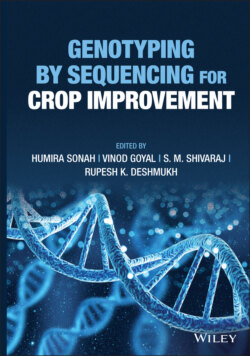Читать книгу Genotyping by Sequencing for Crop Improvement - Группа авторов - Страница 72
3.7 Applications and Successful Examples of Whole‐Genome Resequencing
ОглавлениеOne of the important applications of whole‐genome resequencing is to explore the genetic diversity at the sequence level. Rice has known to be species that shows genetic diversity not at species level but within the genus as well. The 3000 rice genome sequencing has led to the capture of the sequence variation in the genome which aids to decipher population differentiation (local and global population), construct new reference genome, pan‐genome of varieties, haplotyping, and SNP discovery (Li et al. 2014b). Further, previously characterized genes have also been analyzed for haplotype diversity which can be employed in haplotype‐based breeding (Abbai et al. 2019). Another example includes the study of evolutionary history by genome resequencing in peach fruit (Yu et al. 2018).
For the identification of genetic traits associated with complex traits, genome wide association study (GWAS) has been employed. It helps in the recognition of many SNPs involved with the target trait either by correlation or comparative analysis. Abbai et al. (2019) selected 664 cultivated rice accessions for GWAS from the 3K rice genome. In the case of salt‐tolerant traits, they identified the possible candidate gene and causal polymorphism by performing genetic variation, haplotyping, integrated gene information, and homology analysis. As the precise superior haplotype identification will have a great impact on the molecular breeding outcome. Similarly, Lin et al. (2021) explored weediness‐related traits from the 3K rice genome project in the cultivated pool. They identified weediness‐associated markers by performing GWAS within each subpopulation. One of the examples involved GWAS in rice for the salt‐tolerant trait as shown in Figure 3.2 (Yuan et al. 2020). With the help of WGR, it has been possible to construct a high‐quality HapMaps in maize and rice which help to perform GWAS and find unidentified genetic variations of agronomically important traits. The applications of WGR have led to a decrease in the cost of WGS as well as enabled the generation of large data of sequences.
The online resources available for rice, soybean, canola, maize, and wheat are widely being used for the marker development, allele mining, haplotypic evaluation as well as simple applications like gene family characterization (Deshmukh et al. 2016; André et al. 2017; Rasoolizadeh et al. 2018; Chaudhary et al. 2019c; de Ronne et al. 2020; Singh et al. 2019). The free access of resources more particularly in rice and soybean has accelerated basic as well as applied research in these crops.
Apart from the high‐throughput applications, WGR is helpful for specific applications like characterization of varieties developed with marker‐assisted breeding, characterization of introgression lines, and evaluation of transgenic events (Patil et al. 2018; Tayade et al. 2018; Shivaraj et al. 2019). Similarly, resequencing also helps for bulk evaluation‐based approaches like Mut‐Map and QTLseq (Bansal et al. 2019; Chaudhary et al. 2019a; Kumawat et al. 2019). Very recent advancements like genome editing also have implication of WGR (Mushtaq et al. 2019; Vats et al. 2019; Ansari et al. 2020). Mutations at target sites as well as at off‐target can be easily verified with whole‐genome resequencing.
